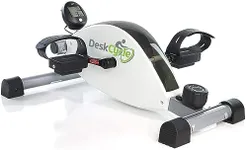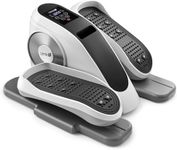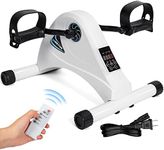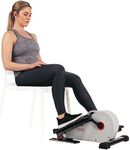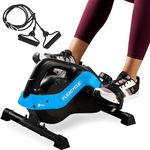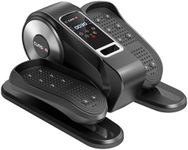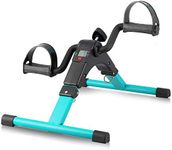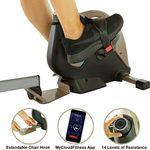Buying Guide for the Best Under Desk Bike
Choosing an under-desk bike is a great way to stay active while working or studying. These compact exercise machines fit under your desk and allow you to pedal while sitting, helping to improve circulation, burn calories, and boost energy without interrupting your workflow. When picking the right under-desk bike, it's important to consider how and where you'll use it, your fitness goals, and your comfort preferences. Understanding the key features will help you find a model that fits seamlessly into your daily routine and keeps you motivated to move.Size and PortabilitySize and portability refer to how much space the under-desk bike takes up and how easy it is to move around. This is important because you want the bike to fit comfortably under your desk without bumping your knees, and you may want to store it away when not in use. Smaller, lighter models are easier to move and fit in tighter spaces, but may feel less stable. Larger, heavier bikes are more stable but take up more room. If you have a compact workspace or plan to move the bike often, look for a lightweight, compact design. If stability is your priority and you have enough space, a larger model may be better.
Pedal Resistance LevelsPedal resistance levels determine how hard it is to pedal and how much of a workout you get. This is important because it allows you to adjust the intensity of your exercise to match your fitness level and goals. Resistance is usually adjustable, with some bikes offering a few basic levels and others providing a wide range. Lower resistance is good for gentle movement and long sessions, while higher resistance is better for building strength and burning more calories. If you want flexibility, choose a bike with multiple resistance settings so you can start easy and increase the challenge as you get stronger.
Noise LevelNoise level refers to how much sound the bike makes when you pedal. This matters if you work in a quiet office, share a space, or want to avoid distractions. Quieter bikes use magnetic resistance or smooth mechanisms, while louder ones may use friction or have less refined parts. If you need a silent environment, look for models advertised as quiet or with magnetic resistance. If noise isn't a concern, you have more options to choose from.
Pedal Design and ComfortPedal design and comfort involve the shape, size, and grip of the pedals, as well as whether they have straps. This is important because comfortable pedals make it easier to use the bike for longer periods and prevent your feet from slipping. Some pedals are designed for use with shoes, while others can be used barefoot. If you plan to pedal for long stretches or wear different types of footwear, look for wide, textured pedals with adjustable straps for a secure and comfortable fit.
Display and Tracking FeaturesDisplay and tracking features refer to whether the bike has a screen that shows your workout stats, such as time, distance, speed, and calories burned. This is important if you want to monitor your progress and stay motivated. Some bikes have simple displays, while others offer more detailed tracking or even connect to apps. If you like to keep track of your activity, choose a bike with a clear, easy-to-read display and the tracking features that matter most to you.
Stability and Build QualityStability and build quality describe how sturdy and well-made the bike is. This is important for safety and comfort, especially if you plan to use the bike frequently or at higher resistance levels. A stable bike won't wobble or slide around, making your workout smoother and safer. Look for models with a solid frame, non-slip feet, and good reviews for durability. If you want a long-lasting product, prioritize build quality and stability.


